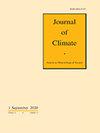Atmospheric rivers are responsible for cyclicity in Sierra Nevada precipitation
IF 4.8
2区 地球科学
Q1 METEOROLOGY & ATMOSPHERIC SCIENCES
引用次数: 0
Abstract
Abstract Cool-season (November–March) precipitation contributes critically to California’s water resources and flood risk. In the Sierra Nevada, approximately half of cool-season precipitation is derived from a small proportion of storms classified as atmospheric rivers (ARs). The frequency and intensity of ARs are highly variable from year to year and unreliable climate teleconnections limit forecasting. However, previous research provides intriguing evidence of cycles with biennial (2.2-year) and decadal (10–20-year) periodicities in Sierra Nevada cool-season precipitation, suggesting it is not purely stochastic. To identify the source of this cyclicity, we decompose daily precipitation records (1949–2022) into contributions from ARs vs non-ARs, as well as into variations in frequency and intensity. We find that the biennial and decadal spectral peaks in Sierra Nevada precipitation totals are entirely due to precipitation delivered by ARs, and primarily due to variations in the frequency of days with AR precipitation. While total non-AR precipitation correlates with sea-surface temperature (SST) and atmospheric pressure patterns associated with the El Niño-Southern Oscillation, AR precipitation shows no consistent remote teleconnections at any periodicity. Supporting this finding, atmospheric simulations forced by observed SSTs do not reproduce the biennial or decadal precipitation variations identified in observations. These results, combined with the lack of long-term stable cycles in previously published tree-ring reconstructions, suggest that the observed biennial and decadal quasi-cyclicity in Sierra Nevada precipitation is unreliable as a forecasting tool.大气河流是内华达山脉降水周期性的原因
摘要 冷季(11 月至次年 3 月)降水对加利福尼亚州的水资源和洪水风险起着至关重要的作用。在内华达山脉,大约一半的冷季降水量来自于一小部分被归类为大气河流(ARs)的风暴。ARs 的频率和强度每年变化很大,不可靠的气候远程联系限制了预测。然而,先前的研究提供了内华达山脉冷季降水两年(2.2 年)和十年(10-20 年)周期性循环的有趣证据,表明它并不纯粹是随机的。为了确定这种周期性的来源,我们将每日降水记录(1949-2022 年)分解为 ARs 和非 ARs 的贡献,以及频率和强度的变化。我们发现,内华达山脉降水总量的两年期和十年期频谱峰值完全是由于自回归降水造成的,主要是由于自回归降水日频率的变化造成的。虽然非太阳辐射降水总量与厄尔尼诺-南方涛动相关的海面温度和大气压力模式有关,但太阳辐射降水在任何周期都没有显示出一致的遥感联系。与这一发现相佐证的是,以观测到的 SST 为动力的大气模拟并不能再现观测到的两年或十年降水量变化。这些结果,再加上以前发表的树环重建中缺乏长期稳定的周期,表明观测到的内华达山脉降水的两年期和十年期准周期性作为预报工具是不可靠的。
本文章由计算机程序翻译,如有差异,请以英文原文为准。
求助全文
约1分钟内获得全文
求助全文
来源期刊

Journal of Climate
地学-气象与大气科学
CiteScore
9.30
自引率
14.30%
发文量
490
审稿时长
7.5 months
期刊介绍:
The Journal of Climate (JCLI) (ISSN: 0894-8755; eISSN: 1520-0442) publishes research that advances basic understanding of the dynamics and physics of the climate system on large spatial scales, including variability of the atmosphere, oceans, land surface, and cryosphere; past, present, and projected future changes in the climate system; and climate simulation and prediction.
 求助内容:
求助内容: 应助结果提醒方式:
应助结果提醒方式:


